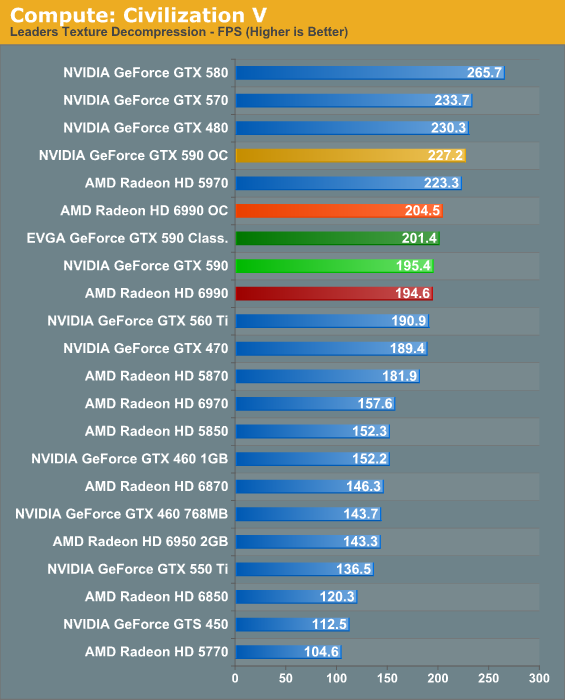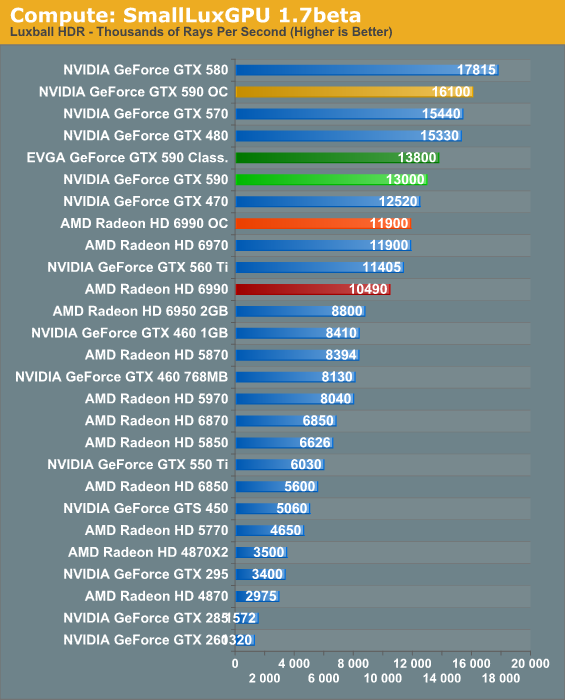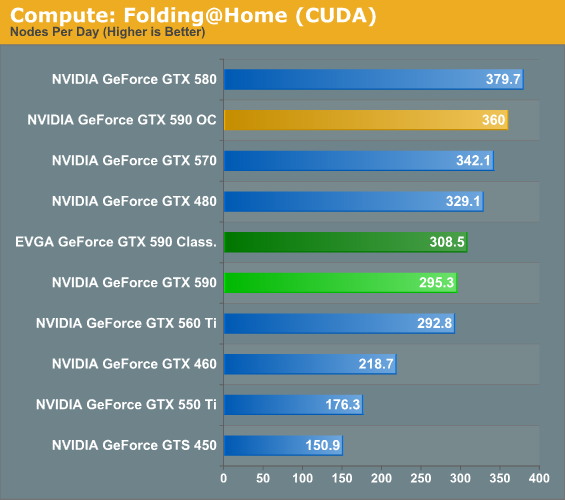NVIDIA’s GeForce GTX 590: Duking It Out For The Single Card King
by Ryan Smith on March 24, 2011 9:00 AM ESTCompute
Moving on from our look at gaming performance, we have our customary look at compute performance.
Our first compute benchmark comes from Civilization V, which uses DirectCompute to decompress textures on the fly. Civ5 includes a sub-benchmark that exclusively tests the speed of their texture decompression algorithm by repeatedly decompressing the textures required for one of the game’s leader scenes.

In the game world Civ5 benefits significantly from SLI and CrossFire. For our texture compression test however AFR is more a liability than a benefit. This doesn’t impact the game in any meaningful manner, but it’s an example of how SLI/CF aren’t always the right tool for the job. Unfortunately for both parties, with as few compute applications as there are today, almost none of them benefit from SLI/CF.
Our second GPU compute benchmark is SmallLuxGPU, the GPU ray tracing branch of the open source LuxRender renderer. While it’s still in beta, SmallLuxGPU recently hit a milestone by implementing a complete ray tracing engine in OpenCL, allowing them to fully offload the process to the GPU. It’s this ray tracing engine we’re testing.

SmallLuxGPU only currently supports ray tracing with one GPU, so all of our results are effectively proxies for what would be if the GTX 590 only had one GPU. Not surprisingly overclocks do wonders here, and NVIDIA’s strong compute architecture gives them an easy win. SLI/CF performance will become more important here when we upgrade to LuxMark for our next iteration of our benchmark suite, as LuxMark can handle multiple OpenCL drivers.
Our final compute benchmark is a Folding @ Home benchmark. Given NVIDIA’s focus on compute for Fermi, cards such as the GTX 590 can be particularly interesting for distributed computing enthusiasts, as two GPUs should be able to quickly retire work units.

Folding@Home doesn’t directly benefit from CF/SLI at all. However by dispatching one WU to each GPU it’s possible to double effective performance. With that taken into account the GTX 590 is quite an effective cruncher, particularly when we start looking at overclocking.










123 Comments
View All Comments
RaistlinZ - Thursday, March 24, 2011 - link
What about the 6950 2GB? It can be had for $245.00 after rebate and it's plenty powerful.the_elvino - Thursday, March 24, 2011 - link
Is it so hard to admit that the 6990's performance is better across the board? Multi-monitor setups were left out in order to make NVidia look good.Remember when the GTX 580 SLI review was published, AT didn't include a 5970 crossfire setup, because they sadly only had one 5970.
Yes, the GTX 590 is less noisy, but then again you can underclock the 6990 to GTX 590 performance levels and it will be quieter too, not really an argument.
The GTX 590 is slower (especially at super high resolutions) and draws more power than the 6990 at the same price, AMD wins! Simple!
softdrinkviking - Thursday, March 24, 2011 - link
If the 590 can only drive 2 displays, is the reason it has 3 DVI ports is only for people who buy 2 cards and then you can run all three off of one card?Ryan Smith - Friday, March 25, 2011 - link
The individual GPUs can only drive 2 monitors each. NVIDIA is using the display capabilities of both GPUs together in order to drive 4 monitors.softdrinkviking - Friday, March 25, 2011 - link
ah, got it. i should read more carefully.thanks for answering. :)
The Jedi - Friday, March 25, 2011 - link
Surely if each GPU can run two displays, two GPUs on one card can run four displays?Soulkeeper - Thursday, March 24, 2011 - link
Wow that is massiveI wouldn't put that in my pc if someone else bought it for me.
hab82 - Friday, March 25, 2011 - link
For me the gaming differences between AMD Nividia at this level would not get me to change allegiance. In my case I bought two EVGA classifieds but they may never see a game. I use them as low cost replacements to the Telsa cards. For Parallel processing I held off until we had powers of two ie 256 512 1024 cores. I did not like 240 432 480 alternatives. Just easier to work with powers of 2. The lower noise and lower power were big winners. Evan if the power supplies can handle them you still have to get the heat out of the room. My 4 nodes of 1024 cuda cores each are a pain to air condition in my den.I really love you gamers, you buy enough GPU's to keep the competition going and lowering the price for impressive computation power.
Thanks all!
Hubert
Calin - Friday, March 25, 2011 - link
USA manages to stay just south of Canadars2 - Friday, March 25, 2011 - link
I thought you guys learned your lesson the last time you pitted a factory-overclocked reference nVidia card against a stock AMD card. If you're going to use an overclocked card in an article that's meant to establish the performance baseline for a series of graphics cards (as this one does for the GTX 590 series), then you really should do at least one of:1. Downclock the overclocked "reference" card to stock levels.
2. Overclock the competing AMD card by a comparable amount (or use a factory overclocked AMD card as the reference point)
3. Publish a review using a card that runs at reference clocks, and then afterwards publish a separate review for the overclocked card.
4. Overclock both cards to their maximum stable levels, and use that as the comparison point.
Come on now, this is supposed to be Anandtech. It shouldn't be up to the readers to lecture you about journalistic integrity or the importance of providing proper "apples to apples" comparisons. Using a factory overclocked card to establish a performance baseline for a new series of GPU's is biased, no matter how small and insignificant the overclock may seem. Cut it out.